Sparc Teams General Overview Stages V2
- 1. November 12, 2009 Version 2.0 Ending Unemployment General Overview
- 2. ŌĆ£ Very helpful for a positive attitude and changing negative thoughts into positive opportunities.ŌĆØ ~ Neil (42) Bristol ŌĆ£ An intriguing and refreshing mind-opener.ŌĆØ ~ Daniel, (39) Bristol ŌĆ£ Fascinating insight into many of the hurdles I have been creating for myself in attempting to sell my skills to others.ŌĆØ ~ Trefor (52) Bristol ŌĆ£ Wow. No one has ever asked me before what I was passionate about.ŌĆØ ~ Mark (19) Bristol ŌĆ£ Well thought out and delivered well by the team.ŌĆØ ŌĆ£ Realised my own value and importance of community.ŌĆØ ŌĆ£ I enjoyed the recognition as well as the presentation of ideas around teams and employment.ŌĆØ ŌĆ£ Very useful and enlightening. Lots of different thoughts for success in work and in life.ŌĆØ ~ Julie, (57) Bristol
- 3. Experiencing Unemployment Today Start of Process Team to Individual End of Process Individual back to Team In general, the experience of unemployment is a process from team to individual, back to team. Individual Chaotic Confusion
- 4. Experiencing Unemployment Today What occurs during this time is tragic and unnecessary: decline in physical health decline in mental well being decrease in societal health (crime) detrimental effects on the youth, families & communities heavy tax burden on others
- 5. Decline in Physical & Mental Health "In the past, we saw people die within 10 years after their job loss. Now, we are seeing them die as early as the same year." ~ Harvey Brenner Ph.D. 1 The link has been established by many professionals over the years irrefutably connecting unemployment with declines in physical and mental health and well-being. Research shows depression, hopelessness and boredom to critical degrees. Eisenberg and Lazarsfeld, Psychological Well-Being and the Great Depression, 1938 1.2% increase in total mortality 1.7% increase in cardiovascular disease 1.3% more cirrhosis cases (index of alcohol consumption) 1.7% more suicides - Dr. M. Brenner: "Influence of the Social Environment on PsychologyŌĆØ, 1979 For every 10% increase in the number of unemployed there is a: Two to three years after increased unemployment, compromised general deterioration of health with increased mortality from cardiovascular disease. - Dr. M. Brenner, 1987 1 | At the Health Industries Council meeting on March 11, 2009 in Irving, CA; USA, Harvey Brenner, Ph.D, professor of public health and behavioural sciences at the University of North Texas Health Science Centre's School of Public Health.
- 6. Decline in Societal Health 1 | At the Health Industries Council meeting on March 11, 2009 in Irving, CA; USA, Harvey Brenner, Ph.D, professor of public health and behavioural sciences at the University of North Texas Health Science Centre's School of Public Health. For every 10% increase in the number of unemployed there are: ŌĆ£ Undeniable links found between unemployment and many indicators of social dislocation like crime.ŌĆØ - Fagan and Freeman, 1997 Research shows the link to criminal behaviour and prolonged dependence on parents of the unemployed. Additional research points to the detrimental effects on the youth of unemployed parents on many levels. - Eisenberg and Lazarsfeld, Psychological Well-Being and the Great Depression, 1938 - Dr. M. Brenner, 1987 0.4% more arrests 0.8% more assaults reported to the police ŌĆ£ Unemployment is the ŌĆśinvisible handŌĆÖ -- carrying a stick -- that keeps the workforce in line.ŌĆ£ ~ David Schweickart, ŌĆ£After CapitalismŌĆØ, 2002
- 7. What is Missing? ~ Well-Being RESEARCH by Marie Jahoda, a British social psychologist, developed the theory of ŌĆśIdeal Mental HealthŌĆÖ 1 . Here she identified five categories vital to feelings of well-being. 1 | Marie Jahoda, ŌĆ£Employment and Unemployment: A Social-psychological AnalysisŌĆØ Cambridge University Press, 1982, (theory first developed in1958) She determined the unemployed are deprived of all five. Time Structure Social Contact Collective Effort or Purpose Social Identity or Status Regular Activity
- 8. Solution: Just Get Them a Job? NO. Only the ŌĆśsatisfied employedŌĆÖ resulted in significant differences in psychological well-being from the unemployed and the dissatisfied employed. In general, the relative scores translate into there being psychological issues in: 39.7% of the unemployed 39.2% of the dissatisfied employed 21.4% of the satisfied employed 1 | General Health Questionnaire Studies: Goldberg, 1972; Wing 1980; Banks, Clegg, Jackson, Kemp, Stafford and Wall, 1980 Quite a bit of research shows that the ŌĆśdissatisfied employedŌĆÖ are adversely effected to a similar degree or even to a greater degree than the unemployed 1 . ŌĆ£ The ŌĆśdissatisfied employedŌĆÖ have remarkably greater psychological issues than even the unemployed.ŌĆØ - Anthony, Harold, Winefield, ŌĆ£Growing Up With UnemploymentŌĆØ 1993 ŌĆ£ Oh, you hate your job? Why didn't you say so? There's a support group for that. It's called EVERYBODY, and they meet at the bar.ŌĆØ - Drew Carey, Comedian
- 9. Solution: A New Process? YES. Start of Transition Organisational Team to Sparc Teams End of Transition Sparc Teams back to Organisational Team Engage at every stage. Within Transition Keep or Create Momentum Leaving Organisation A Sparc Teams Programme Entering Organisation B
- 10. 7 Stages of Engagement Start of Transition Organisational Team to Sparc Teams End of Transition Sparc Teams back to Organisational Team Within Transition Increase Skills, Experience & Create Value 1 5 6 7 3 4 2 Stage 1 : Engage at Notice Stage 2 : Engage at Exit Stage 3: Engage Deeper at 2 Weeks Stage 4: Engage in Work Teams at 6 Months Stage 5 : Engage When Offer is Given Stage 6 : Engage During First 90 Days Stage 7: Engage Company Champion Dangerous Territory Ensure Long-Term Success
- 11. Stage 1: Engage at Notice At the time notice is given, real feelings of anxiety and depression begin. If engagement occurs immediately after notice, motivation and employability remain high. Stage 1 : This is the most crucial time. If engagement can occur at notice and prior to the person leaving the organisation the transition time will be dramatically shortened. Denial Depression Anger Sleeplessness Anxiety Because these feelings are real and occur immediately after notice is given*. Isolation Loss of energy Feeling numb Appetite changes Physical symptoms * Or earlier, as within organisations with several waves of downsizing. 1
- 12. Stage 1 Engagement: Fast Track Programme A supportive and proactive programme can ease the sense of alienation and depression which occur at notice. The Fast Track Programme is a combination of: ’ü┤ Proactive Workshops | from Managing Transitions to Personal Understanding ’ü┤ Conscious Connections | the process of signposting and making connections for immediate placement Assumption: the organisation will provide desk, phone, computer, internet, printing capabilities, etc. for a period of time
- 13. Stage 1 Engagement: Fast Track Programme Example of two workshops: Managing Transitions In part, utilising the William Bridges Model, we assist people in understanding the steps to take with any transition to increase their likelihood of reaching their goals. This method has been in use for over 30 years and hundreds of thousands of individuals have been through the process. This process includes understanding the feelings associated with any transition as well as easy steps to go through the transition to reach your goals. Personal Understanding = Short-Term Employability & Long-Term Job Placement Knowing oneŌĆÖs skills and experience along with their passions is just the start of an effective search process. Identifying and communicating to the right potential employers clearly and effectively significantly shortens the career transition time and decreases the amount of rejection letters. In part, we utilise the Tom Peters model of personal branding, PIESS model and others.
- 14. Stage 2: Engage at Exit At the time of exiting the organisation, all 5 areas vital to well-being are being deprived. A this stage a person is at risk for depression and other issues which decrease desire and motivation to proactively seek employment. Without a programme and ŌĆśa place to goŌĆÖ all 5 areas vital to well-being are lost, immediately . 2 Time Structure Social Contact Collective Effort or Purpose Social Identity or Status Regular Activity Stage 2 : At this stage having a place to go is critical . If returning to their place of past employment is not an option, all 5 categories of well-being will be deprived upon exit.
- 15. Having ŌĆśa place to goŌĆÖ alleviates the broken routine. Also, offering a compelling number of services in one place will help in attracting people in transition to this one stop shop motivate centre to find a job. The Sparc Space Programme consists of: Stage 2 Engagement: Sparc Space Programme ’ü┤ Career Transition Services Providing services needed to proactively assist someone in their job search: printing, business wear, internet access, financial & legal advice. ’ü┤ Proactive Workshops From Managing Transitions and Personal Understanding to Effective Teams and Leadership Development ’ü┤ Conscious Connections Events Events created specifically to make real connections with employers. Events focused in industry, trade, role or area specific opportunities
- 16. Having ŌĆśa place to goŌĆÖ alleviates the broken routine imposed by the organisation. RETAIL ACCESSIBLE MOTIVATIONAL SPACE We are currently looking for a street-level retail place within Bristol to be more accessible to those in transition, preferably within the city centre. SERVICES TO INCREASE PROACTIVE SEARCH A one-stop-shop to motivate and encourage proactive employment searches. PARTNERING WITH ORGANISATIONS Partnering with companies with a core competency in service offerings is the key to success. Here are some examples of partners we would love to engage: - Printing: Moo - Second-hand Business Wear: Oxfam Boutique - Second-hand Computers / Office Supplies - Caf├® with Internet Access: Co-ExistŌĆÖs Canteen Stage 2 Engagement: Sparc Space Programme CANTEEN
- 17. The Vision ŌĆśa great place to goŌĆÖ Public Services Member Services ’ü┤ VALUE EXCHANGE BUSINESS WEAR BOUTIQUE ’ü┤ MOTIVATIONAL MAKEOVER ’ü┤ PRINTING SERVICES ’ü┤ CAFE 1st ’ü┤ INSPIRED SERVICED CO-WORKING SPACE for SPARC TEAMS, ENTREPRENEURS, FREELANCERS, INDEPENDENT CONTRACTORS, SMALL BUSINESS & ASSOCIATIONS ’ü┤ THEATRE & DISCUSSION AREAS 2nd 3rd ’ü┤ EVENT / WORKSHOP SPACE ’ü┤ PRIVATE MEETING ROOMS ’ü┤ PROFESSIONAL ADVISORY SERVICES CANTEEN
- 18. Woolworths Space (in discussion)
- 19. Stage 3: Engage Deeper at 2 Weeks 3 After two weeks, if not within a programme, self-esteem levels drop, stress ensues and motivation has waned. Stage 3 : At this stage, it is necessary to get over the hump by engaging in a structured team-based programme specifically centred around job search to decrease stress and increase motivation/job search activity. After two weeks additional stress and worry about long term unemployment kicks in.
- 20. Stage 4: Engage in Work Teams at 6 Mo. If still unemployed after 6 months, the chances of long-term employment along with critical health factors ensue. Stress and depression could be at dangerous levels effecting the individual, families and the community. Stage 4 : Re-engaging in actual work is essential at this stage. Engaging in a structured team-based work programme will replace all areas vital to well-being . And, creating value for an organisation increases the likelihood of a position within that organisation. The human instinctual desire to create value and be a valued member of the community is almost non-existent at this stage. The likelihood of severe depression is very high. 4
- 21. Stage 5: Engage When Offer is Given A new type of engagement is needed at this stage when a person if offered a position. Patterns of lethargy, if not in the Sparc Teams Programme, may sabotage any offer. If in a programme, the fear of entering into a new transition may occur as well. Stage 5 : Managing the transition from inside the programme (or not in any programme) into a new state is absolutely necessary. Change, and the need to go through another transition, is a natural fear . Unconscious sabotage may occur at this point unless this transition is managed properly. 5
- 22. Stage 6: Engage During First 90 Days Support during the first 90 days of employment can assist in ensuring a smooth transition and long-term employment with the new organisation. Entering into a new team and organisation has its own set of challenges and fears. Understanding Teams and Group Dynamics will ensure a smooth transition. Engaging at this stage will increase the likelihood of long-term employment . Stage 6 : Managing the transition into a new team and reality can be challenging. Through support this transition can be successful in the short-term and ensure long-term employment. 6
- 23. Stage 7: Engage Company Champion Once an integral part of an organisation, the individual can become a company champion for the programme. Staying a part of the wider community can increase the likelihood of others being successful in their transition to employment. Role-modelling, diversity and connectedness are all part of a vibrant and robust local economy. Staying engaged with each member keeps the community strong and safe while increasing the communityŌĆÖs ability to better handle any crisis. Stage 7 : Keeping the successfully employed engaged, at least in part, with the ŌĆśrest of the communityŌĆÖ is a winning strategy for the long-term health of the community as a whole. 7
- 24. Summary ’ü┤ Proactive Workshops: - Managing Transitions - Goal Setting - Communicate Effectively to Employers Stage 1 : Engage at Notice Stage 2 : Engage at Exit Stage 3: Engage Deeper at 2 Weeks Stage 4: Engage in Work Teams at 6 Mo. Stage 5 : Engage When Offer is Given Stage 6 : Engage During First 90 Days Stage 7: Engage Company Champion Dangerous Territory Ensure Long-term Success SOLUTIONS ’ü┤ A Place to Go - Unstructured Programme of Workshops ’ü┤ A Place to Go - Structured Programme of Workshops ’ü┤ Structured Team-Based Work Programme Parallel Paths of Work Teams AND Proactive Job Search ’ü┤ Support & Encouragement - Managing Transition Workshops ’ü┤ Advice & Coaching - Understanding Teams ’ü┤ Continued Support/Mentoring Others Sparc Teams Value Exchange
- 25. Providing Services Currently working on: Creating levers of influence: organisations, government, recruitment/employment companies, media, etc. Programme and Workshop Development Local Partnerships Getting the Space! [email_address] | 0777 329 7331 Any assistance you can offer would be greatly appreciated!

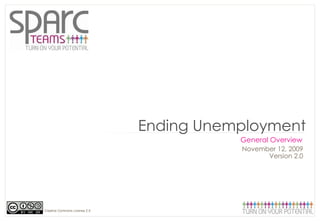









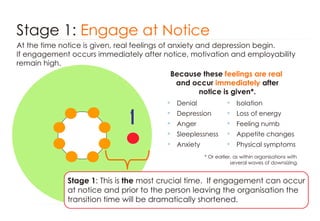



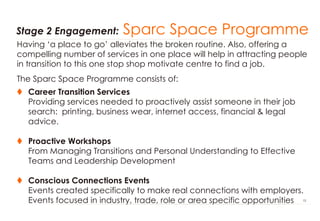
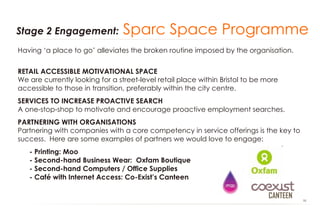




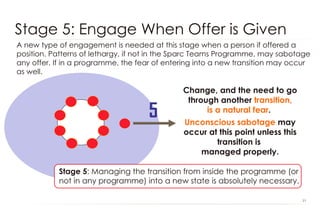


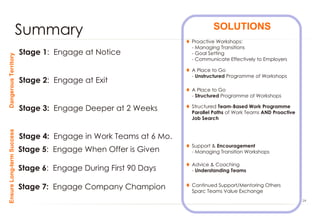
![Providing Services Currently working on: Creating levers of influence: organisations, government, recruitment/employment companies, media, etc. Programme and Workshop Development Local Partnerships Getting the Space! [email_address] | 0777 329 7331 Any assistance you can offer would be greatly appreciated!](https://image.slidesharecdn.com/sparcteamsgeneraloverviewstagesv2-12598714762244-phpapp01/85/Sparc-Teams-General-Overview-Stages-V2-25-320.jpg)